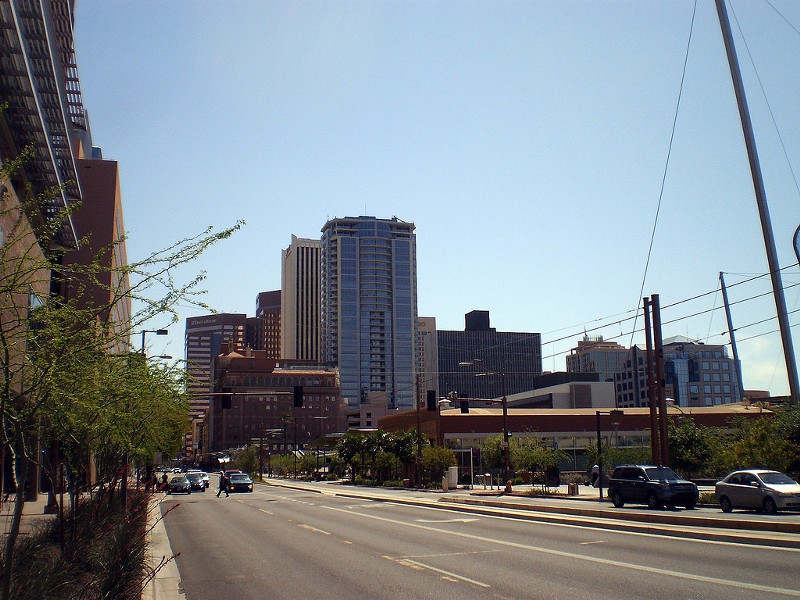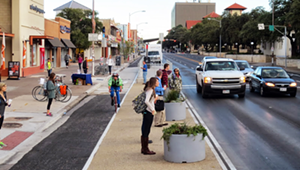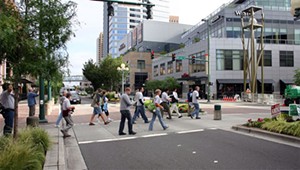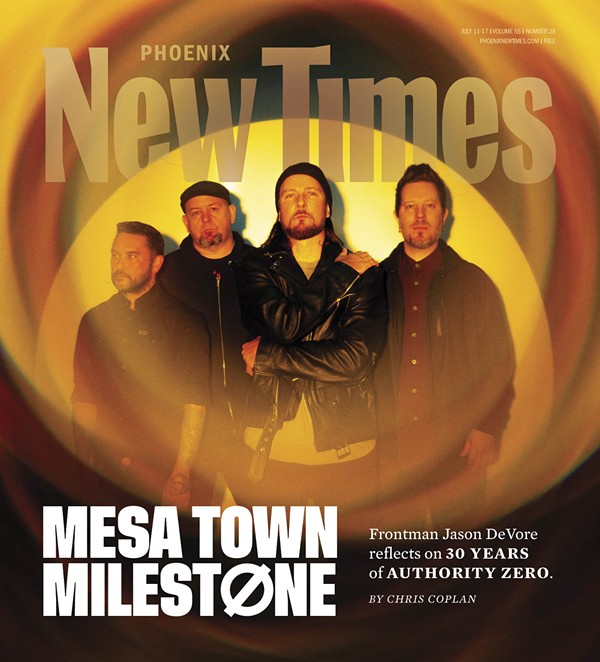Wide roads. High speed limits. No crosswalks for miles.
Phoenix's urban sprawl is deadly for pedestrians. During the first few months of 2018, the death toll averaged one fatality nearly every three days.
Advocates for bicycle and pedestrian safety are fed up, and they're pushing the city to take action. Their priority is to get the City Council to adopt new design guidelines to make the streets safer.
The potential changes have been a long time coming.
In June 2014, the Phoenix City Council adopted a "complete streets" ordinance with the goal of making the city's streets as safe for bicyclists and pedestrians as cars. While that might not seem like a controversial position to take, it represented a major shift in philosophy.
"For decades, Phoenix streets have been designed with one unrivaled goal in mind: moving as many cars as quickly as possible," the Arizona Republic wrote at the time. "Now, that planning mentality is being pushed aside as city leaders question the negative impacts of six-lane surface streets with few amenities for pedestrians and bikers. They want to change Phoenix's reputation as car-centric."
Fast forward nearly four years. Arizona has the highest pedestrian death rate in the nation, and Phoenix is still as car-centric as ever. Between 2014 and 2017, fatal collisions killed 271 pedestrians in Phoenix, according to reports from the National Highway Traffic Safety Administration's Fatality Analysis Reporting System and the Phoenix Police Department. So far in 2018, 30 people have been killed while walking.
What went wrong? Well, for one thing, while the ordinance that the City Council passed in June 2014 said that Phoenix's streets should be safer, it didn't go into detail about how to accomplish that. Figuring out specific design guidelines was supposed to be the job of the Complete Streets Advisory Board, which the City Council created a month later.
That advisory board, which is made up of various stakeholders such as pedestrians, bicyclists, and people who use public transit, has proposed a set of design guidelines that they'd like to implement. It's modeled after the National Association of City Transportation Officials' Urban Street Design Guide, which has been endorsed by the Federal Highway Administration.
Among the suggestions: Designing streets for slower speeds, making sure that they're adequately lighted, and adding bike lanes to all major commercial thoroughfares.
But the city council has yet to vote on the recommendations, for reasons that can be summed up with one word: Bureaucracy. The guidelines have been slowly making their way through a series of committees and subcommittees, with private developers also weighing in.
"This type of process can and has been lengthy," acknowledged Monica Hernandez, a spokesperson for the Phoenix Street Transportation Department.
Meanwhile, the relationship between the advisory board and the city's street transportation department has soured to the point that the staff member charged with overseeing the board tried to eliminate it altogether.
In an internal memo shared with Phoenix New Times and dated February 12, 2017, deputy street transportation director Mark Melnychenko complained that "little has been achieved even though a large amount of energy and resources has been spent by the City on preparing for meetings, coordinating efforts, and attempting to educate CSAB members."
He then went on to say that the advisory board hadn't been willing to accept the department's suggestions: "Recommendations on all aspects of the Complete Streets Program from staff are overridden or neglected by the CSAB due to advocacy and an unwillingness to adhere to the requirements of staff that work with various stakeholders on CIP [Capital Improvement Program], bicycle, and pedestrian and development review on a daily basis."
Melnychenko's name has been redacted in the copy of the memo that's linked above, but Hernandez confirmed that he had authored the memo and that its intended recipient was Ray Dovalina, who served as the department's director at the time.
"Street Transportation staff should lead the Complete Streets Program without the CSAB that has impacted any significant progress," his missive concludes. "The CSAB has stymied efforts to build a partnership with the Planning and Development Department and development community and has hindered all efforts to develop a series of realistic documents that could move through an approval process or be implemented."
Asked about the memo, Hernandez downplayed the conflict, noting that only the Phoenix City Council has the power to make any changes to the board.
"While we welcome an environment where city staff is encouraged to bring ideas and issues to management’s attention, none of the recommendations in the memo were pursued or acted upon," she wrote in an email. "The Street Transportation Department has continued to carry out its responsibility to provide professional staff support to the Complete Streets Advisory Board for them to complete their charge."
Melnychenko's suggestion to eliminate the advisory board doesn't reflect the department's official position, she added: "The recommendations in the memo were not supported by the Director when the memo was submitted, nor are they supported by the current Street Transportation Director."
Nonetheless, Sean Sweat, a member of the Complete Streets Advisory Board who also serves as the president of the Urban Phoenix Project, argues that the memo is proof that the street transportation department is actively trying to obstruct the work of its advisory board.
"Since when has it been a good idea to let bureaucrats operate without oversight?" he wrote in an email to Phoenix New Times. "Council wouldn't have had to create the Complete Streets Advisory Board if the Street Transportation Department had already been designing safe streets. But they weren't, so the Council created an oversight board to get Phoenix on the right track."
He added, "Staff's herculean effort to neuter and marginalize the Council's Complete Streets Advisory Board is just further proof of why that department needs more oversight. The board is important because Phoenix has some of the deadliest streets in the nation, and they are deadly by design. The Complete Streets Advisory Board is the Council's strongest effort yet to make our streets safer, and their work must be allowed to move us forward."
In any case, the deadlock could be coming to an end soon. Last week, Connor Descheemaker, a member of the Complete Streets Advisory Board, submitted a citizen petition asking the mayor and city council to adopt the design guidelines that the board developed — essentially circumventing the need to have Street Transportation staff recommend those guidelines to the council for approval.
The Street Transportation department, naturally, isn't supportive.
"The department’s position is to keep the current review and comment process in place, which entails the item going before the appropriate Boards and Commissions for review and input prior to its submission to the Transportation and Infrastructure Subcommittee and City Council," Hernandez wrote.
The council will vote on the petition Wednesday, April 18.
(UPDATE: The Phoenix City Council voted on April 18 to speed up the process of approving design standards for safer streets. See the follow-up story by clicking here.)
[
{
"name": "Air - MediumRectangle - Inline Content - Mobile Display Size",
"component": "18478561",
"insertPoint": "2",
"requiredCountToDisplay": "2",
"watchElement": ".fdn-content-body",
"astAdList": [
{
"adType": "rectangle",
"displayTargets": "mobile"
}
]
},{
"name": "Editor Picks",
"component": "16759093",
"insertPoint": "4",
"requiredCountToDisplay": "1",
"watchElement": ".fdn-content-body",
"astAdList": [
{
"adType": "rectangle",
"displayTargets": "desktop|tablet"
},{
"adType": "rectangle",
"displayTargets": "desktop|tablet|mobile"
}
]
},{
"name": "Inline Links",
"component": "17980324",
"insertPoint": "8th",
"startingPoint": 8,
"requiredCountToDisplay": "7",
"maxInsertions": 25
},{
"name": "Air - MediumRectangle - Combo - Inline Content",
"component": "16759092",
"insertPoint": "8th",
"startingPoint": 8,
"requiredCountToDisplay": "7",
"maxInsertions": 25,
"watchElement": ".fdn-content-body",
"astAdList": [
{
"adType": "rectangle",
"displayTargets": "desktop|tablet"
},{
"adType": "rectangle",
"displayTargets": "desktop|tablet|mobile"
}
]
},{
"name": "Inline Links",
"component": "17980324",
"insertPoint": "8th",
"startingPoint": 12,
"requiredCountToDisplay": "11",
"maxInsertions": 24
},{
"name": "Air - Leaderboard Tower - Combo - Inline Content",
"component": "16759094",
"insertPoint": "8th",
"startingPoint": 12,
"requiredCountToDisplay": "11",
"maxInsertions": 24,
"watchElement": ".fdn-content-body",
"astAdList": [
{
"adType": "leaderboardInlineContent",
"displayTargets": "desktop|tablet"
},{
"adType": "tower",
"displayTargets": "mobile"
}
]
}
]












